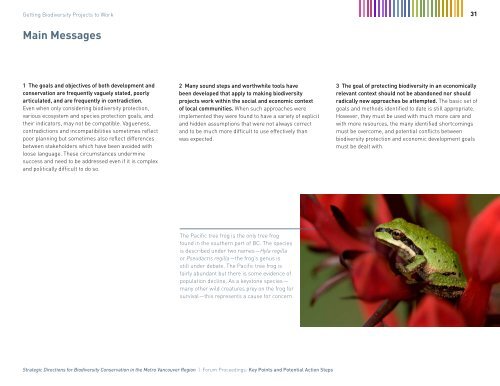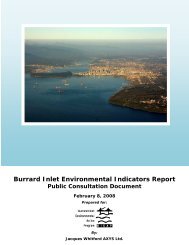Biodiversity Conservation - the BIEAP and FREMP Website
Biodiversity Conservation - the BIEAP and FREMP Website
Biodiversity Conservation - the BIEAP and FREMP Website
You also want an ePaper? Increase the reach of your titles
YUMPU automatically turns print PDFs into web optimized ePapers that Google loves.
Getting <strong>Biodiversity</strong> Projects to Work<br />
Main Messages<br />
1 The goals <strong>and</strong> objectives of both development <strong>and</strong><br />
conservation are frequently vaguely stated, poorly<br />
articulated, <strong>and</strong> are frequently in contradiction.<br />
Even when only considering biodiversity protection,<br />
various ecosystem <strong>and</strong> species protection goals, <strong>and</strong><br />
<strong>the</strong>ir indicators, may not be compatible. Vagueness,<br />
contradictions <strong>and</strong> incompatibilities sometimes reflect<br />
poor planning but sometimes also reflect differences<br />
between stakeholders which have been avoided with<br />
loose language. These circumstances undermine<br />
success <strong>and</strong> need to be addressed even if it is complex<br />
<strong>and</strong> politically difficult to do so.<br />
2 Many sound steps <strong>and</strong> worthwhile tools have<br />
been developed that apply to making biodiversity<br />
projects work within <strong>the</strong> social <strong>and</strong> economic context<br />
of local communities. When such approaches were<br />
implemented <strong>the</strong>y were found to have a variety of explicit<br />
<strong>and</strong> hidden assumptions that were not always correct<br />
<strong>and</strong> to be much more difficult to use effectively than<br />
was expected.<br />
The Pacific tree frog is <strong>the</strong> only tree frog<br />
found in <strong>the</strong> sou<strong>the</strong>rn part of BC. The species<br />
is described under two names—Hyla regilla<br />
or Pseudacris regilla—<strong>the</strong> frog’s genus is<br />
still under debate. The Pacific tree frog is<br />
fairly abundant but <strong>the</strong>re is some evidence of<br />
population decline. As a keystone species—<br />
many o<strong>the</strong>r wild creatures prey on <strong>the</strong> frog for<br />
survival—this represents a cause for concern.<br />
Strategic Directions for <strong>Biodiversity</strong> <strong>Conservation</strong> in <strong>the</strong> Metro Vancouver Region | Forum Proceedings: Key Points <strong>and</strong> Potential Action Steps<br />
31<br />
3 The goal of protecting biodiversity in an economically<br />
relevant context should not be ab<strong>and</strong>oned nor should<br />
radically new approaches be attempted. The basic set of<br />
goals <strong>and</strong> methods identified to date is still appropriate.<br />
However, <strong>the</strong>y must be used with much more care <strong>and</strong><br />
with more resources, <strong>the</strong> many identified shortcomings<br />
must be overcome, <strong>and</strong> potential conflicts between<br />
biodiversity protection <strong>and</strong> economic development goals<br />
must be dealt with.
















